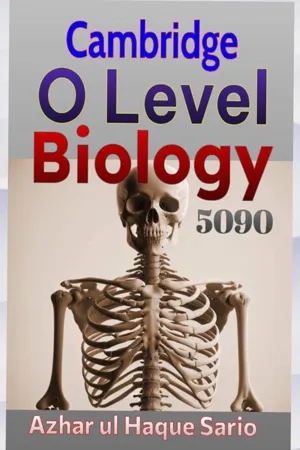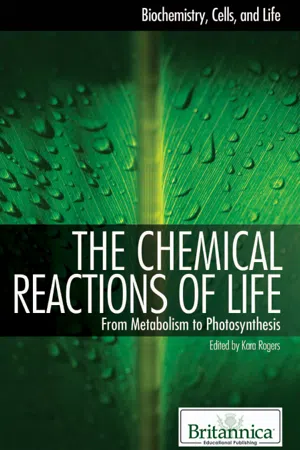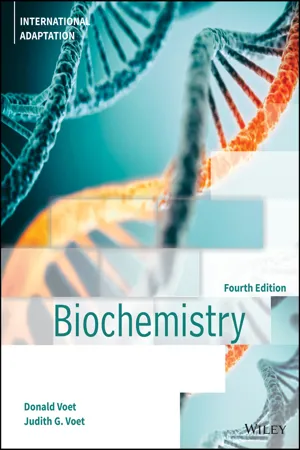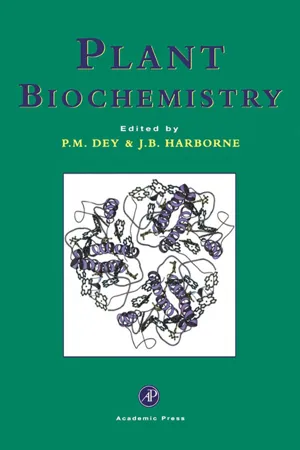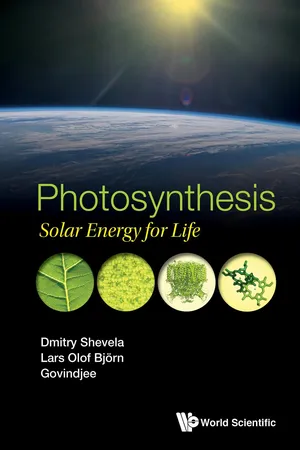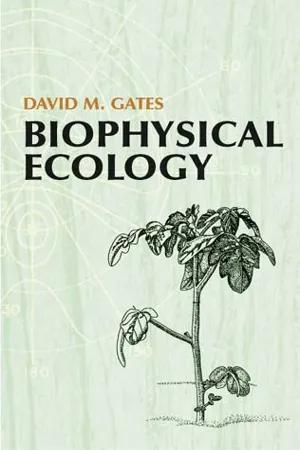Biological Sciences
Light-Independent Reaction
The light-independent reaction, also known as the Calvin cycle, is a series of biochemical reactions in photosynthesis that occur in the stroma of chloroplasts. It uses the products of the light-dependent reactions to convert carbon dioxide into glucose. This process does not directly require light and is responsible for the synthesis of organic molecules in plants.
Written by Perlego with AI-assistance
Related key terms
Related key terms
1 of 4
Related key terms
1 of 3
9 Key excerpts on "Light-Independent Reaction"
- Elhadi M. Yahia, Armando Carrillo-Lopez(Authors)
- 2018(Publication Date)
- Woodhead Publishing(Publisher)
In this reaction, the NADPH and ATP previously produced in the light-dependent reaction are used for the fixation of CO 2 into carbohydrates. An enzyme (ribulose bisphosphate carboxylase-oxygenase) is responsible for carbon dioxide fixation, in a metabolic reaction known as the Calvin cycle. These reactions occur when light reaches the leaf, and stomata are open, allowing the entry of CO 2 to photosynthetic cells. Each requirement for plant growth and development depends on the internal energy balance, which is the result of carbon assimilation in photosynthesis. Carbohydrates derived from photosynthesis are the energy source for plant maintenance (using glucose for the cell respiration process) in the first instance, and then to support metabolic energy needs for growth, when structural carbohydrates like cellulose are also required. Consequently, dry matter is accumulated which is subsequently distributed internally in the plant for the development of new structures such as branches, wood, flowers, and fruits. In this way, dry matter (storage assimilates) and carbon flow derived from photosynthesis are allocated during fruit growth and development. Therefore, fruit development, maturation, ripening, and quality are influenced by the process of photosynthetic activity, which is the reason for the great importance of this process (photosynthesis), not only during the development of horticultural commodities (fruits, vegetables, flowers), but also its consequences during postharvest- eBook - ePub
- Azhar ul Haque Sario, Azhar ul Haque Sario(Authors)
- 2023(Publication Date)
- tredition(Publisher)
Photosynthesis is vital for life on Earth. It is the primary process by which energy enters the biosphere. Plants use this process to produce glucose, which serves as a fundamental energy source for many organisms, including humans. Additionally, photosynthesis is responsible for producing the majority of the oxygen in the Earth's atmosphere, which is crucial for the survival of aerobic organisms.Light-Dependent Reactions: These reactions occur in the thylakoid membranes of chloroplasts. They involve the absorption of light by chlorophyll and other pigments, which drives the synthesis of ATP (adenosine triphosphate) and NADPH (nicotinamide adenine dinucleotide phosphate). Water molecules are split in this process, releasing oxygen as a by-product. Light-Independent Reactions (Calvin Cycle): These reactions take place in the stroma of chloroplasts. They use the ATP and NADPH produced in the lightdependent reactions to convert carbon dioxide into glucose. This process does not require light directly but depends on the products of the light-dependent reactions.2. Factors Affecting Photosynthesis Several factors influence the rate of photosynthesis: Light Intensity: Increased light intensity boosts the rate of photosynthesis, up to a certain point.Carbon Dioxide Concentration: Higher levels of CO2 can enhance photosynthesis until the process reaches a saturation point.Temperature: Photosynthesis has an optimal temperature range. Deviations from this range can slow down the process. Water Availability: Adequate water supply is crucial for photosynthesis, especially for the stability of the plant and the efficiency of enzymatic reactions. 3. Implications in Biology and Ecology Photosynthesis is not just a biochemical process; it has profound implications in various fields:Ecology: It forms the basis of most food chains and food webs, determining the energy flow in ecosystems. Agriculture: Understanding photosynthesis aids in enhancing crop yields and managing agricultural ecosystems. - eBook - ePub
The Chemical Reactions of Life
From Metabolism to Photosynthesis
- Britannica Educational Publishing, Kara Rogers(Authors)
- 2010(Publication Date)
- Britannica Educational Publishing(Publisher)
Pathway of carbon dioxide fixation and reduction in photosynthesis, the reductive pentose phosphate cycle. The diagram represents one complete turn of the cycle, with the net production of one molecule of Gal3P. The nine molecules of ATP and six molecules of NADPH come from the light reactions. Copyright Encyclopædia Britannica; rendering for this edition by Rosen Educational ServicesFurther studies with 14 C as well as with inorganic phosphate labelled with 32 P led to the mapping of the carbon fixation and reduction pathway called the reductive pentose phosphate cycle (RPP cycle). An additional pathway for carbon transport in certain plants was later discovered in other laboratories. All the steps in these pathways can be carried out in the laboratory by isolated enzymes in the dark. Several steps require the ATP or NADPH generated by the light reactions. In addition, some of the enzymes are fully active only when conditions simulate those in green cells exposed to light. In vivo, these enzymes are active during photosynthesis but not in the dark.Melvin Calvin (b. April 8, 1911, St. Paul, Minn., U.S.—d. Jan. 8, 1997, Berkeley, Calif.) American biochemist Melvin Calvin was known for his discovery of the chemical pathways of photosynthesis. He was awarded the 1961 Nobel Prize for Chemistry for his work.Calvin was the son of immigrant parents. His father was from Kalvaria, Lith., so the Ellis Island immigration authorities renamed him Calvin; his mother was from Russian Georgia. Soon after his birth, the family moved to Detroit, Mich., where Calvin showed an early interest in science, especially chemistry and physics. In 1927 he received a full scholarship from the Michigan College of Mining and Technology (now Michigan Technological University) in Houghton, where he was the school’s first chemistry major. Few chemistry courses were offered, so he enrolled in mineralogy, geology, paleontology, and civil engineering courses, all of which proved useful in his later interdisciplinary scientific research. Following his sophomore year, he interrupted his studies for a year, earning money as an analyst in a brass factory. - eBook - ePub
- Markus Keller(Author)
- 2020(Publication Date)
- Academic Press(Publisher)
It is achieved by the action of 13 enzyme proteins in the Calvin cycle located in the chloroplast stroma. The Calvin cycle is named after one of its discoverers, the American biochemist Melvin Calvin, but is also called the photosynthetic carbon reduction cycle or the reductive pentose phosphate pathway. The cycle proceeds in three successive stages (Fig. 4.4). The first stage is termed carboxylation and combines CO 2 and protons derived from water with ribulose-1,5-bisphosphate, a molecule that specializes as a carbon acceptor, to generate two intermediate molecules of 3-phosphoglycerate, thereby converting the inorganic CO 2 into an organic molecule. As its name suggests, this initial organic compound, like all other intermediates of the Calvin cycle, is a sugar phosphate. Despite the simplified and convenient equation introduced above, glucose is not a direct product of the Calvin cycle. Because 3-phosphoglycerate is the first stable product of CO 2 fixation and contains three carbon atoms, grapevines are grouped with most other crop plants as the so-called C 3 plants. Fig. 4.4 The three stages of the Calvin cycle that converts CO 2 into carbohydrates. Illustration by M. Keller. The carboxylation step is catalyzed by the enzyme ribulose bisphosphate carboxylase/oxygenase (or rubisco for short). Owing to its importance in carbon assimilation, rubisco occurs in chloroplasts at very high concentration—often in substantial excess. It represents approximately one-third of a leaf's total protein complement, appropriating up to half of the leaf's nitrogen, which arguably makes it the most abundant protein nature ever invented (Spreitzer and Salvucci, 2002). Rubisco commandeers an extremely prominent position in grapevine physiology because almost all the carbon that is assimilated is initially “captured” by this protein. As its full name suggests, the enzyme “works” in two opposing directions so that CO 2 competes with oxygen for the same molecular acceptor - eBook - ePub
- Donald Voet, Judith G. Voet(Authors)
- 2021(Publication Date)
- Wiley(Publisher)
The second stage reshuffles the atoms of five GAPs to reform the three RuBPs with which the cycle began, a process that requires no further input of free energy or reduction equivalents. The sixth GAP, the product of the Calvin cycle, is used to synthesize carbohydrates, amino acids, and fatty acids. The flux-controlling enzymes of the Calvin cycle are activated in the light through variations in the pH and the Mg 2+ and NADPH concentrations, and by the redox level of thioredoxin. The central enzyme of the Calvin cycle, RuBP carboxylase, catalyzes both a carboxylase and an oxygenase reaction with RuBP. The latter reaction is the first step in the photorespiration cycle that liberates CO 2. The rate of photorespiration increases with temperature and decreases with CO 2 concentration, so photorespiration constitutes a significant energetic drain on most plants on hot bright days. Calvin cycle products are converted to sucrose, starch, and cellulose, as well as fatty acids and amino acids. C 4 plants, which are most common in the tropics, have a system for concentrating CO 2 in their photosynthetic cells so as to minimize the effects of photorespiration but at the cost of 2 ATP per CO 2 fixed. Certain desert plants conserve water by absorbing CO 2 at night and releasing it to the Calvin cycle by day. This crassulacean acid metabolism (CAM) occurs through a process similar to the C 4 cycle. Problems 1. Why is chlorophyll green in color when it absorbs in the red and the blue regions of the spectrum (Fig. 21-5)? 2. The “red tide” is a massive proliferation of certain algal species that cause seawater to become visibly red. Describe the spectral characteristics of the dominant photosynthetic pigments in these algae. 3. (a) H 2 18 O is added to a suspension of chloroplasts capable of photosynthesis - eBook - ePub
- P. M. Dey, J. B. Harborne(Authors)
- 1997(Publication Date)
- Academic Press(Publisher)
2Photosynthesis
J.R. Bowyer and R.C. Leegood2.1 Introduction 2.2 Light energy utilization to produce ATP and NADPH 2.3 The Benson-Calvin cycle 2.4 Photorespiration2.5 C4 photosynthesis2.6 Crassulacean Acid Metabolism Acknowledgements Background reading Further reading Other references2.1 INTRODUCTION
Photosynthesis is the process by which organisms convert light energy into chemical energy in the form of reducing power (as NADPH or NADH) and ATP, and use these chemicals to drive carbon dioxide fixation and reduction to produce sugars. In oxygenic photosynthetic organisms, including higher plants, the source of reducing equivalents is H2 O, releasing O2 as a by-product. The overall reaction of oxygenic photosynthesis can be represented as:CO2 + 2H2 O → (CH2 O) + H2 O + O2This process is responsible for producing virtually all the O2 in the atmosphere and for fixing about 1011 tons of carbon from CO2 into organic compounds annually.The sugars produced by the photosynthetic fixation of CO2 provide raw material for the biosynthesis of all the organic molecules found in plants. They are also the source of the chemical fuel which is oxidized by oxygen in the mitochondria in order to generate ATP for use in a wide variety of energy-consuming processes in the plant such as biosynthesis, active transport of ions and metabolites across membranes, and intracellular movement of organelles.In plants, photosynthesis occurs primarily in leaf cells in organelles called chloroplasts, which are about 5 μm long and bound by two membrane envelopes. The number of chloroplasts per leaf cell varies from 1 to over 100, depending on cell type, species and growth conditions. - eBook - ePub
- Jennifer W. MacAdam(Author)
- 2011(Publication Date)
- Wiley-Blackwell(Publisher)
Figure 10.6 ). During the light reactions of photosynthesis, both ATP and NADPH accumulate in the stroma, where they can be used in the synthesis of carbohydrates. These reactions are called the “light” or photochemical reactions of photosynthesis because they utilize light energy to create the chemical energy of ATP and NADPH, and therefore only take place in the light.The “dark” reactions of photosynthesisAs long ago as 1905, it was determined that in dim light, altering the temperature at which photosynthesis was occurring did not affect the rate of photosynthesis, but increasing the light intensity did. However, in bright light, the rate of photosynthesis was affected by change in temperature, while a further increase in light had no effect. The rate of biochemical reactions of living organisms increases with increasing temperature within the temperature range at which the organism thrives. Investigation of these differences led to the early understanding of photosynthesis as a group of photochemical (“light”) reactions linked through ATP and NADPH to a group of biochemical (“dark”) reactions. In dim light, photosynthetic rate is limited by the photochemical (or light) reactions in which the energy of light is captured and converted to ATP and NADPH. However, in bright light, the rate of the light reactions is high, but photosynthesis can be limited by the rate of the associated biochemical (or dark) reactions that use the energy created in the light reactions to make carbohydrates.In reality, both the light and dark reactions of photosynthesis occur only in the light. The biochemical reactions are termed the dark reactions simply to indicate that light intensity is not a direct regulatory factor. In the dark, when the flow of chemical energy from the light reactions has stopped, then the dark reactions stop for lack of ATP and NADPH. - eBook - ePub
Photosynthesis
Solar Energy for Life
- Dmitry Shevela, Lars Olof Björn, Govindjee(Authors)
- 2018(Publication Date)
- WSPC(Publisher)
Chapter 3
Basics of Photosynthesis: Light-Dependent Reactions
3.1Overview: Harvesting Sunlight to Drive Redox Chemistry
In all photosynthetic organisms (both oxygenic and anoxygenic) the photosynthetic light reactions begin with the absorption of light (photons) by pigments in light-harvesting complexes, embedded in the thylakoid membrane (or in case of cyanobacteria, also in phycobilisomes). The antenna (both outer and inner) systems deliver the energy of absorbed light (excitation energy; we shall discuss it in Section 3.2 ) to pigment–protein reaction center complexes, Photosystems II and I (PSII and PSI; see Section 3.3 ), both embedded in the thylakoid membrane (Fig. 3.1 ). As a consequence of primary photochemistry, which takes place after trapping of the excitation energy by special photoactive chlorophyll (Chl) molecules in the reaction centers of the two photosystems, light energy is converted into chemical energy. This energy drives the redox chemistry of the stepwise linear electron “transfer” from water to the oxidized form of nicotinamide adenine dinucleotide phosphate (NADP+ ), involving PSII and PSI as well as the Cytb6 fcomplex (Fig. 3.1 ). In this chapter we shall also briefly describe photosynthetic ATP production by ATP synthase from ADP and inorganic phosphate (see Section 3.3.3 ).3.2Capturing the Energy of Light
The first step in photosynthesis is the absorption of light by pigment molecules which include Chla, other Chls, or phycobilins, or fucoxanthol, depending on the organism; this step occurs within femtoseconds (one femtosecond is 10−15 s; there are as many femtoseconds in a second as there are seconds in 31.54 million years!). This event means that a photon disappears, and the energy of the molecule increases, the pigment molecule is in an excited state. We need to consider only two kinds of energy of the molecule here: the electronic energy and the vibrational energy, and both are changed when the photon is absorbed, as a consequence of the so-calledFranck-Condon principle: Upon absorption of a photon, the electronic transition from the ground state to the excited state occurs without a change in the position of the nuclei, because “the electrons are light and the nuclei are heavy,” and the molecule goes to a higher vibrational state (see Fig. 3.2 , and the discussion that follows; for Franck-Condon principle, see Rabinowitch and Govindjee [1969], and Atkins and Friedman [1999]). In addition, we have “vibronic” energy, which is a combination of “vibrational” and “electronic” energy: the “vibronic energy coupling” refers to the interaction between electronic and nuclear vibrational energy. This interaction, indeed, makes the light harvesting more efficient in several cases [Deanet al. - eBook - ePub
- David M. Gates(Author)
- 2012(Publication Date)
- Dover Publications(Publisher)
Chapter 14Photosynthesis
Introduction
In order to improve our understanding of the physiological ecology of plants, we wish to develop an analytical model of whole-leaf photosynthesis that will relate the metabolic processes within plant leaves to conditions of light, temperature, humidity, wind, and concentration of carbon dioxide and oxygen near the plant. In order to begin our formulation, we must first understand some of the general characteristics of photosynthesis.Primary productivity, or photosynthesis, is fundamental to all life on earth. Photosynthesis fixes approximately 6 × 1013 kg of carbon into organic compounds each year. The atmosphere contains 70 × 1013 kg of carbon, which is supplied to plants in the form of CO2 at an atmospheric concentration of 0.03% (vol/vol). The carbon source for photosynthesis in lakes, rivers, and oceans is in the form of CO2 and dissolved in the water. It is estimated that 90 × 1013 kg of carbon is exchanged each year between the oceans and the atmosphere, mostly by physical and chemical processes. The terrestrial biosphere contains a total carbon reservoir of 176 × 1013 kg, and the oceans contain 3,900 × 1013 kg. In addition to exchanging carbon dioxide, plants also exchange water vapor and oxygen with the atmosphere.Photosynthesis
Biochemistry of Photosynthesis
Photosynthesis is an extremely complex series of reactions which uses the energy of visible light to reduce CO2 to sugar. The overall process consists of those reactions which convert light energy into chemical energy (light reactions) and those which fix CO2 into carbohydrate (dark reactions). The former require the presence of light, whereas the latter can occur in the dark if the proper energy-rich compounds, ATP and NADPH2 , are present.The light reactions begin with the absorption of light quanta by chlorophyll molecules and excitation (increased energy levels) of electrons in the pigment. Several hundred chlorophyll molecules are associated in an array much like an antenna, with one special chlorophyll molecule that acts as a reaction center gathering excited electrons and passing them on to the electron-transport chain. Excited electrons pass on to the reaction center and then through the electron-transport chain, which captures the energy as ATP and NADPH2 . The electrons lost from the chlorophyll are replaced by electrons obtained from the splitting of water, with molecular oxygen being produced as a by product. The ATP and NADPH2 are used in the dark, or Calvin cycle, reactions, in which CO2 is converted to sugar. Initially, CO2 and ribulose diphosphate (RuDP) are combined in the presence of RuDP carboxylase to give two molecules of phosphoglycerate. ATP and NADPH2
Index pages curate the most relevant extracts from our library of academic textbooks. They’ve been created using an in-house natural language model (NLM), each adding context and meaning to key research topics.
Explore more topic indexes
Explore more topic indexes
1 of 6
Explore more topic indexes
1 of 4

